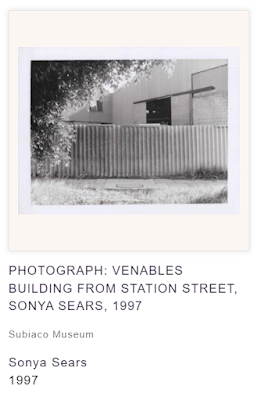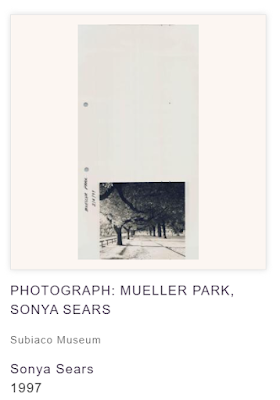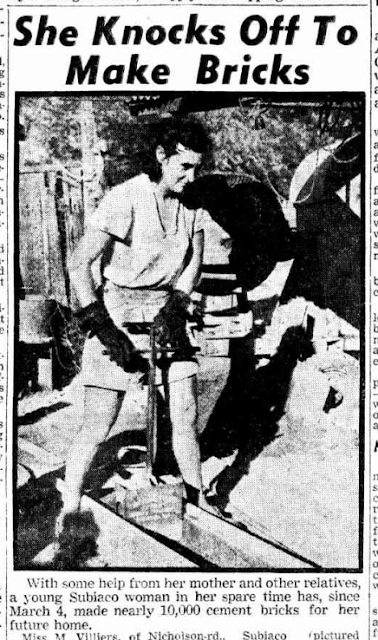"My Day At The Royal Show" (1919).
This blog post is a continuation of the previous two blog posts about the children's corner "Childland" in the Western Australian newspaper W.A. Family Sphere published from 1919 -1920.
This week in Western Australia is the third term school holidays. It is also the week of the Perth Royal Agricultural Show. Like many generations of children and families before them they will be going to the Royal Agricultural Show. Over a one hundred years ago children shared their experiences in the newspaper W. A. Family Sphere in a competition. Their entries are copied below.
From the previous blog post..."The W. A. Family Sphere newspaper was published on Fridays from June 1919 to December 1920. The newspaper had a children's corner titled the 'Childland Times'. Children wrote letters about what interest them, entered competitions and won prizes and shared their creative work such as stories and drawings which were published.
The section contained material deemed suitable for children including short stories and riddles and jokes. The section was edited by an adult known as Tiggie Touchwood and the children were known as 'childlanders'. This children's section was different from other children's sections in that the children won money for competitions and had their work published as against other newspapers who rewarded children with books and games or just having the work published and receiving a reply from the adult editor. The newspaper while publishing the names of the children who wrote in, did not publish their address or age and only if they won a competition."
The articles are from Trove the national database of the National Library of Australia. The photograph is from the State Library of Western Australia. No copyright infringement intended.
W.A. Family Sphere, 31 October 1919.
"My Day at the Show" Competition
The Prize-Winners.
A large number of my young friends accepted my invitation to enter (without knocking) for the essay competition entitled
"My Day, at the Show." It was in two divisions — for children 12 and under, and for children between 12 and 14 years of age. Here are the results : — 12 and Under. The amount allotted to each division was 7s. 6d., and at first I thought it would be best to give 5s. for first prize and 2s. 6d. for second. I find, however, that I cannot separate the essays sent in by Harry Rogers and Dorothy Cress-well, while little A. Starr's essay is also very good, so I've given it a dead heat for the first pair, with 3s, each, and a close second to A. Starr, who wins Is. 6d.
From Harry Rogers - aged 12, "The Wattles," King-street, Claremont:— The Royal Show has just passed, and I suppose everybody went to it. We saw throngs of people going into the grounds one after the other. Of these days special trains are run, carrying eager spectators.
On Thursday it is Children's Day, and fill the children gather for a good time. On the Thursday I went and had as good a time as anyone else. The first thing I went to see was the machinery, and as I am going to be a farmer I was very interested; then I went to see the various exhibits, such as dogs, cattle, sheep and poultry.
The best thing I saw was a fat little pony, reserved champion, well brushed, combed and looked after. I saw the bees in their hive, and I thought what wonderful little creatures they are, and how smart they must be to gather in the honey for people to eat.
I thought there was a fine show of vegetables tables, butter and bacon; there was some of , the best colored butter I ever saw, and some fine rhubarb. In the Children's Hall I saw some walking sticks and some riding whips, which the boy's at Baker's Hill made.
Then I went to see the sideshows, some of which were hoopla, kicko, duckla, merry-go-round and swinging boats. There we heard the cry of "Hoopla, penny a shot!".
Then came the grand parade, which was a very magnificent sight. One of the cows kept running rings around the man who was leading it, and he had a job to hold it in. Then, after watching the jumping, I walked home tired and weary.
From Dorothy Cresswell (age 10 years and 4 weeks), Griver-street, Cottesloe: —
Dear Tiggie Touchwood,— As I went to the Show I will try and give you an idea how I enjoyed myself. Firstly, it was so unexpected, as my mother was in bed with the 'flu. We thought that there was no Show for us, but my auntie arrived from West Guildford, and said she would take my brother and me, and I was so pleased. So off we went, and when we arrived all we could see were people, some ladies with beautiful dresses and hats.
I went and saw the machinery, but I did not understand it; and the animals were very nice, but I liked the ring events best of all. The horses were lovely. Tiggie, didn't you think the flowers were lovely? I went through and saw the children's work, and some of the writing was beautiful for children. Of course, I went on the roundabouts a few times, and had a few ice creams, nuts and lollies.
I went home early, as I missed my mother taking us into different places, as I lost my auntie and I was very tired of it, and did not want to go again on children's day. I think your letter on the Show was splendid.
You saw a lot more than I did, and really, Tiggie, I did not enjoy my self a lot. With love and best wishes.
From A. Starr (aged 10 years), of 97 Railway Parade, Mt. Lawley: — On October 1 two of my chums and myself decided that if we could we would go to the Show. We decided to catch the 9.36 a.m. train from Mt. Lawley. One of my chums was detained, so couldn't get away for another hour.
On arriving at the Show grounds we first went, to see the sheep shearing and machinery. After strolling round, a bit we ran into a tent, and on reading the notice we found it to be the "double" fowl's tent. We paid our money and went in. There, in the middle of a table with a wire cage on it for the bird.
After looking at it, we proceeded to the poultry and dogs' sheds. One of the dogs had five pups. After look ing at some more exhibits we had lunch. For about another hour we looked round the various sheds and halls. Then, to miss the crowd, we made a move towards the gates, arriving home, about 4.30 p.m.
Second Division— 12 to 14 1/2.
While the essay sent me by my young friend Dudley Myers is very, bright and long, that belonging to Eric Richards is clever and well written, and again I am unable to separate then, so must mark another dead heat of it, awarding 3s. each to Dudley and Eric, while Thelma Rogers (a sister to Harry) wins the second prize of 1s. 6d.
From Dudley Myers (aged 13 years and 10 months), of 49 Aberdeen-street, East Perth : — .
It is Wednesday (there is magic in the word), the great day for gods and little fishes. The auror of morn is still hovering over the Oriental horizon when I awake and perform my toilet, conjecturing and anticipating what pictures the magic and mysterious mirror of Time and Fate will disclose.
Arriving at the station, I take my seat in a comfortably crowded carriage, just as the train moves out. At every station the tiny tots ask "Is this Claremont?" But at last Claremont is reached, and the poor harassed mother is beset by the following questions and requests: " 'Ere, give us my ticket," "Where is my money?" and so on. A loud wail from here and there tells a silent (?) tale of suffocation.
Following the crowd I reach the show ground, and perceiving that the ring events have not yet commenced, make a tour of the side shows. The first attraction that meets my eye is that of the "Mysterious Gourka from Banglore." "Here you are, gents; come and see the Mysterious Gourka from Banglore, the wonder of the 19th century," cries the manager. (I venture to correct his mistake as regards the nineteenth century, but he is too busy leading more lambs to the slaughter.) "Passing through we view the "Mysterious Gourka" (?) who, when he perspires, mixes a suspicious chocolate-brown with the perspiration.
A little further on is His Majesty's highest subject, who casually informs us, as if saying good day, that the size of his boot is 13, and that he can pass a florin through his ring. About ten yards east of this establishment is the spruiker of Salome, vainly trying to induce two cockies to enter and view that marvellous lady, but who knowingly wink to each other and help themselves "to a free look" via the photos on the outside.
Then again there is the freak fowl : "Roll up in your thousands, see this marvellous fowl, 2ft, high (my uncle possesses a Game Malay rooster 2ft, l0 in. high), left side female, right side male." Passing in, we see a fowl with a color less comb, and by appearance half-dead , (just as Tiggie described it). I called it a well-planned (?) fraud, and reckoned it had two dummy feet attached to the wings by; a piece of string. As for it being fifty-fifty has it ever been proved?
Seeing the crowd turning their eyes ringward, I do the same, and perceive that the ring events are about to commence. First of all, there is a gentle men's hack, the horses participating earning great credit for their owners. After this there is few more events, consisting of a buggy parade, etc., the majority of which deserve honorable mention.
Having been attacked by a low, sinking feeling in my (oh! you know where !) I proceed to refresh my self with some nutritious aliment at the nearest tea-room. My hunger being satiated, I come out just in time to see " Die trotting commence. My word ! it is a ding-dong struggle for the coveted honor of first place. First one, then the other forge ahead, but it cannot go on forever, and Yundah Boy wins the great event in record time (2.224).
Following this is the Ladies' Hack, in which an unfortunate accident occurs, marring all real interest in the event. But I am glad to say that the unfortunate lady had the presence of mind to hold the hores's head down, thus preventing him from hurting himself further. A few more events not worth penning take place, and the day is ended. So ends my essay.
From Eric Richards (aged 14), of 15 Carr-street, West Perth: —
My Day at the Royal Show.
Of course, everyone who is able always visits the Show, and I was no exception. Nine o'clock on Wednesday saw me on West Perth station, with a return ticket to Claremont. My reason for being abroad so early was that I was entering some flowers in the Show, and I had to have them staged, ready for judging, early. Fortunately, the train was not too crowded, thus enabling me to find a seat.
On arrival at Claremont I hastened to the Show grounds, to which, like the river, flowed a constant stream of merry people. At various places along the road Salvation Army men and women were asking for contributions, and it was good to see that their efforts were rewarded and that people could, amid their happiness and pleasure, find room for a little self-denial.
I was soon through the turnstiles and " into the ground. I did not, however, immediately inspect all the sights to be seen, but staged my flowers to my satisfaction and commenced to walk round and "see the sights."
Attracted by the loud noise, the machinery soon claimed my attention, and it was very interest ing to watch the various engines at work watched by grimy engineers in blue overalls, and imagine to myself what they were built for. The show by Cuming, Smith and Co. on their stand was well worth looking at. All their productions were stacked around in bag?, while here and there pot plants in flower made pretty splashes of color.
I passed the tent wherein was showing the marvellous fowl, but did not enter, passing on to the poultry and dogs. The loud barking of the dogs was heard every where, blended with the crowing of roosters, and it was not exactly musical.
As it was about 12.30 I had lunch and resumed my tour. On going into the hall in which were the vegetables I was surprised to see such exhibits. I next visited the Children's Industries Hall, in which were shown many fine drawings, maps and handwriting. The cookery almost made me inclined to eat it. The main hall was also very attractive, and was very crowded.
My footsteps next turned towards the side shows, around which were a great many people. I had a look at the Mysterious Gourkha, who, as the showman solemnly ; declared, was direct from Bangalore I also had some shots on the hoop-la, but was unsuccessful. Going into the grandstand I watched the ring events, and was amused greatly at the Grand Parade, where some of the animals were very frisky.
Before doing this I had gone to the flower hall, and was gratified to see I had won a second prize. After watching the ring events for some time, I made for home, tired but happy, and after enduring the crowd in the train arrived home safely.
From Thelma Rogers (aged 13 years and 5 months), of "The Wattles" King-street, Claremont :—
The Show. The Royal Agricultural Show— the greatest industrial events of the year — was held from the 7th to 11th of October on the Society's grounds at Claremont. It is indeed a great events and crowds throne to witness it. On those days special trains were running, carrying eager spectators.
On Thursday— Children's Day— I went to the Show, and was one of the children who spent a very enjoyable day. My favorite exhibit was the school children's. I liked the maps and cookery, and thought the sewing was very good, but the things I thought were most clever were some walking sticks made by the boys of Baker's Hill.
The poultry and dogs were the next things I went to see, for I am very fond of dogs. I liked best ; the big, faithful looking Collies and the little Pomeranians. The next things I visited were the sheep and pigs. I liked to the small pigs running over the lazy old mother, who is trying to have "forty winks." I think if all the farmers' pigs are the size of those in the Show it is a wonder he could keep them. Among the sheep I saw one that seemed to stand out more prominent than the rest. It had gained Reserved Champion, Champion, and first prize. It was indeed a magnificent animal, for it hardly had room to move in its, mail apartment.
As I make my way to the side-shows I see that it is the most crowded part of the grounds, and I hear the many voices advertising their various shows. "Hoop-la t Aunt Sally! Kicko ! Skittles ! One for a penny ! "Seven for sixpence." All these cries, are heard as I come into the thick of the throng. The amusement, I think, attracted most attention was the merry-go-round; everyone seemed to go for a; circular ride. Then, after a day's the rough enjoyment, I trudged home.

Crowd around main arena at Claremont Showgrounds 1919. From the State Library of Western Australia.































